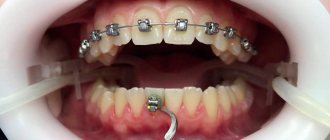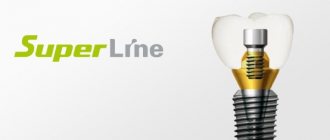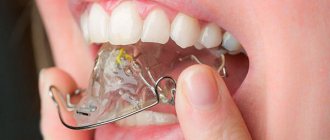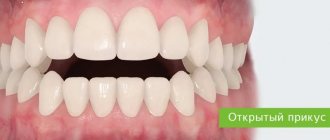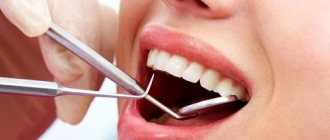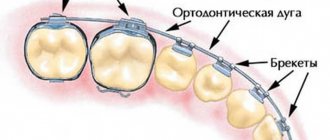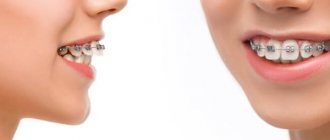Metal braces | Aesthetic designs | Working principle | Addictive | Frequency of doctor visits | Brushing your teeth | Stages of treatment | Differences between ligature and non-ligature devices | Treatment payment schemes
Ligature braces are a reliable tool for occlusion correction, which is used by orthodontists to correct pathologies of low, medium and high degrees of complexity. In braces with ligatures, the arch is fixed with elastic rings or metal wire. Unlike self-ligating systems, classic devices do not have a lid.
The material was verified by Anna Rimkevich, senior product manager at Ormco Russia.
The doctor fixes the arch in the bracket groove with metal or elastic ligatures. Elastic ligatures have the shape of a ring. The rings quickly stretch, change color due to food coloring and sometimes break. Latex loses its elasticity 3 – 4 weeks after installation. On average, the doctor changes ligatures and arches once a month. Metal ligatures are tightly tied over the braces. The wire does not break, but causes noticeable discomfort in the mouth.
elastic ligatures on wood
In non-ligature systems, the cover fixes the arc and closes the groove space. Low friction of the bracket and the arch reduces the treatment period, and the simple mechanism for opening the lid reduces the time spent at the orthodontist’s appointment.
The mechanism of bite correction using braces
Pathologies of occlusion can be congenital, caused by genetic predisposition or abnormalities of intrauterine development, or acquired, caused by bad habits or injuries to the dentofacial apparatus. The use of brace systems in corrective therapy makes it possible to effectively eliminate occlusion defects regardless of the reasons that gave rise to them.
The essence of the mechanism for correcting anomalies is based on the ability of teeth to move from their place under the influence of directed mechanical force. During the treatment process, the bone tissue in which the dental elements are located is thinned in the direction of the movement vector, and a new one is formed in the opposite direction. Thus, the calculated force pressure helps the tooth occupy a new place in the dental row.
The mechanical impact to achieve the goal of corrective therapy is created using bracket systems - non-removable orthodontic structures fixed to the surface of the tooth enamel.
Prices for ceramic braces in 2022
The cost of treatment consists of various factors - the choice of the manufacturer of the orthodontic system, the level of the clinic and the complexity of the bite pathology. One of the best systems is Clarity Advanced ceramic braces; the average cost of installation on both jaws is 175,000 rubles. Also on the list of leaders is the Damon 3 model, which stimulates the physiological processes of teeth. The price of this system is similar. The Clarity SL brand is also popular - these ceramic braces are reliable, do not stain and look as aesthetically pleasing as possible. The price is about 185,000 rubles.
It is also necessary to remember about arch correction sessions; the price of a visit varies from 2000 to 3000 rubles. You need to visit a doctor every month. Removal is paid separately, and if the ceramic bracket comes off, you need to order a new one, for which you also have to pay extra.
The iOrtho clinic network provides high-quality services for correcting malocclusion with Invisalign aligners, sign up for a consultation now!
Design features of ligature braces
All bracket systems have the same design:
- bracket plates fixed to the teeth using a special adhesive composition;
- a power arc that has “shape memory” (tends to straighten out from a bent position);
- fastening elements that attach the arch to the bracket plates.
If the arch is fixed to the teeth using miniature clips, then such braces are called non-ligating or self-ligating braces. If the arch is attached using ligatures, then such orthodontic structures are called ligature. This is, as they say, a “classic of the genre.”
Either small plastic rings or thin metal wire made of medical steel are used as ligatures.
Plastic ligatures can be of various shades: transparent, silver, colored. Teenagers, as a rule, prefer rich colors. While wearing, the ligatures stretch, so the doctor periodically changes or tightens them.
Note: compliance with the prescribed frequency of visits to the clinic during the correction course is the key to the effectiveness of the process. Otherwise, the result may not be achieved.
Ligature braces are effective in treating both adults and adolescents.
How long should you wear braces?
On average, it takes people at least 1 year to completely correct orthodontic defects. It takes approximately three years to correct even the most severe dental defects. The first results from the treatment can be seen already in the first 1 – 3 months from the moment of wearing. If you want to pre-calculate how long it will take to correct your bite in your particular case, consider the following factors:
- Your age;
- complexity of the defect being corrected;
- general condition of teeth;
- distance between teeth;
- type of construction (lingual/vestibular, ligature/non-ligature, metal/sapphire, etc.)
Types of ligature systems
The main classification of braces is carried out depending on their positioning:
- those fixed on the outer side of the dental row are called vestibular;
- attached to the inner surface - lingual.
The material used to make orthodontic products also affects the type of bracket system:
- metal – bracket plates are made of a hypoallergenic metal alloy (cobalt, nickel or gold). Such designs are very reliable, efficient, affordable in cost, but their appearance is not aesthetically pleasing;
- ceramic - made of high-strength ceramics. Their color practically matches the shade of natural tooth enamel, so they have a high level of aesthetics. Cannot be used if excessive force pressure must be applied to correct defects (i.e., to correct severe pathologies). The price of such systems is significantly higher than similar metal products.
How braces work
Any braces system works on the same principle. The design, through simple manipulations, puts some pressure on the crooked teeth, thereby gradually returning them to the desired position. The designs of such systems may differ slightly, but this does not in any way affect the general standards of their operation.
A bracket is a small plate that is attached to the surface of the teeth either from the outside or from the inside. These plates, in turn, are attached to a special wire, which tends to return to its original shape. Consequently, when such a system is fixed on the teeth, the wire will begin to gradually straighten, thereby correcting the position of the teeth.
A metal arc can be attached in various ways, but the result will always be the same.
Indications and contraindications for installation
Any type of treatment should be prescribed exclusively by a specialist. Therefore, identifying indications and contraindications for correcting occlusion defects is a priority step, without which corrective therapy cannot be started.
Indications:
- Incorrect position of the jaws or individual teeth
- Tremas and diastemas (large distances between dental elements)
- Crowding of dental units
- Deep or crossbite
Contraindications:
- Periodontitis and periodontal disease
- Endocrine pathologies
- Severe cardiovascular diseases
- HIV;
- Tuberculosis
- Bone diseases (osteoporosis, osteomyelitis)
- Bleeding disorder
- Edentia (absence of many teeth)
- Oncology
- Mental illness
Important: An orthodontist identifies indications for starting corrective therapy with braces only after conducting a thorough hardware diagnosis. This is necessary to develop an adequate detailed treatment plan.
Stages of corrective therapy
Correcting anomalies of the dental system is a long and painstaking process consisting of several stages:
- visual and hardware diagnostics: computed tomography, teleradiography,
- rendering a verdict, making a diagnosis, determining indications and contraindications;
- development of a treatment plan;
- oral hygiene: treatment of teeth and gums, professional cleaning;
- taking individual measurements (casts or scanning), making a model, drawing up an estimate;
- production of braces;
- installation of a brace system for a patient;
- wearing the device with periodic system adjustments. The duration depends on the severity of the specific clinical case and is determined by the orthodontist;
- removal of braces and installation of a removable or non-removable retainer. The duration of retention also depends on the individual characteristics of the clinical case.
Specialist comment: the retention stage is very important for consolidating the achieved results. Failure to follow the recommendations of the attending orthodontist may invalidate the results of therapy, and everything will return to its previous position.
Manufacturing materials
The price of installing braces directly depends on the materials from which they are made.
They are:
- metal. The most budget-friendly and most effective option for orthodontic structures. They are able to cope with even the most complex anomalies in the oral cavity. The structures are made from medical steel, chrome and sometimes gold. They are comfortable to wear as they do not stain, do not absorb odors and are easy to clean. Their only drawback is their unaesthetic appearance;
- ceramic. They are durable and hypoallergenic. Since ceramics are close in color to tooth enamel, these structures are hardly noticeable in the oral cavity, but this also leads to a disadvantage - they are more expensive than metal ones and do not always cope with severe defects;
- plastic. They compete with metal structures, as they are affordable, but at the same time they are hardly noticeable on the teeth. The clasps in them are made of plastic or polyurethane, matching the tooth enamel. Their disadvantages include low strength and staining from food and drinks;
- sapphire. Almost invisible to others. They are made of aluminum oxide and are hypoallergenic, highly durable and safe. But this type of braces is only suitable for minor malocclusions;
- titanium. The safest designs, characterized by strength, durability and reliability. They are installed on patients suffering from various allergic reactions. Their only disadvantage is that they stand out strongly on the teeth;
- combined. Made from ceramics or sapphires and metal. Their main advantage is efficiency, convenience and aesthetics.
Attention:
the appearance of brace systems does not affect the effectiveness of the treatment process, therefore, which orthodontic structures should be used depends directly on the financial capabilities of the patient, his individual needs and the complexity of the case.
Installation of ligature bracket system
The procedure for fixing the device takes about one and a half hours. What does the doctor do:
- washes the enamel, then thoroughly etches it with a special substance designed for better adhesion of the bracket plates to the surface of the enamel;
- applies an adhesive composition to the areas of future fixation of the plates;
- glues the plates and removes excess adhesive solution;
- threads a power arc into the grooves of the bracket plates;
- fixes the arch with ligatures.
Features of the adaptation period
The patient should be prepared to experience discomfort for several days or weeks (depending on the threshold of sensitivity):
- rubbing of the mucous membranes of the lips and cheeks;
- violation of diction;
- discomfort when eating.
Expert advice for minimizing discomfort:
- to prevent chafing, you can use special wax (sold in pharmacies);
- for minor pain, you should rinse your mouth 3-4 times a day with saline solution (1 tsp per glass of warm water). The procedure cannot be performed if there are wounds and abrasions in the mouth. In this case, it is better to use a soda solution in the same concentration;
- In case of severe pain, you need to take a tablet of any painkiller. Note: strictly follow the dosage indicated in the instructions for the medicine;
- In the first days after installing braces, cancel intense physical training. Yoga exercises will help during this period;
- learn to chop food with a knife, exclude excessively hard or sticky foods (dried, dried) from your diet. During the first few days, the products can be ground in a blender.
Attention: if the pain is severe and does not go away within several days, then you should definitely consult your doctor.
How do ligature-free braces work?
Crooked teeth can be treated with both ligature and non-ligature braces. In the first option, the doctor uses special rubber devices and a metal base to secure the teeth. This creates a reverse force from the jaw muscles, which allows the teeth to be aligned in the correct vertical position.
The difference between self-ligating braces and traditional braces is that they do not create additional pressure on the teeth, but simply fix the dentition. A straightening effect is created, as a result of which the teeth move much more easily.
Advantages of non-ligation braces:
- Aesthetic appearance. Fasteners that are located on the arc look more attractive in comparison with traditional metal fixtures.
- The curvature of the dentition is eliminated more easily due to the absence of friction.
- Getting used to the device in a short time.
- Teeth that interfere with correction are not removed, as was the case with ligature braces.
- Ligature-free braces do not cause mechanical damage to the mucous membrane and soft tissues of the oral cavity. The patient feels virtually no discomfort.
- There are no pain or complications with prolonged wearing.
- Can be removed and reinstalled in a short period of time.
- Patients who have been diagnosed with periodontitis should use only non-ligature braces when correcting their dentition.
- You can visit a personal specialist less often. To adjust the position of braces, it is enough to contact the orthodontist once every 60 days.
Hygienic care
The bracket design has many areas that are very difficult to clean from food debris and plaque. Therefore, hygienic care for them requires special attention and patience. Special devices are used for cleaning (in addition to a regular toothbrush and paste):
- V-shaped brushes;
- brushes of different sizes and bristle angles;
- dental floss (floss);
- irrigator is a device for cleaning hard-to-reach places between teeth and orthodontic elements. The principle of operation is based on the controlled supply of a stream of water (or solution) under pressure.
You should clean your mouth while wearing braces twice a day. Ideally, after every meal. But, if this is not possible, then you need to rinse your mouth thoroughly after eating.
Diet restrictions
To prevent braces from breaking or changing the vector of force, you need to reconsider your diet. Orthodontists recommend:
- hard vegetables and fruits must be grated or crushed in a brander before use;
- You cannot bite seeds, chew gum, eat nuts, dried apricots and other dried fruits;
- Avoid consuming very hot or extremely cold foods and drinks;
- limit the intake of food and drinks containing artificial or natural colors (tea, coffee, red wine, soda, berries, etc.).
Important: failure to follow the recommendations given by a specialist may result in system failure. In this case, the device will need to be repaired, which will lead to an increase in the correction period and an increase in the cost of treatment.
Duration of treatment with self-ligating braces
Self-ligating systems are more modern and comfortable designs for the patient and doctor. Thanks to soft forces and the involvement of the muscular system, teeth straightening occurs faster, more physiologically and is more easily detailed. On average, treatment time with such systems is 20% less than with ligature systems, that is, 1.5-2.5 years. At the same time, fewer visits to the orthodontist are required, since there are no ligatures that require regular replacement.
The Confidence Aesthetic Orthodontics Clinic works with Damon Q and Clear self-ligating braces. According to reviews from our patients, these are the most comfortable systems to care for and wear, with impressive results.

